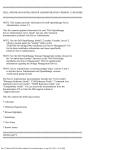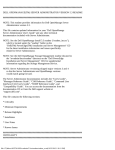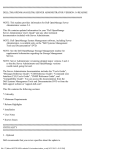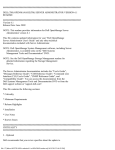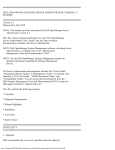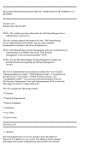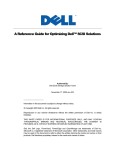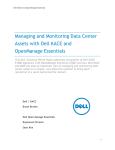Download Dell OpenManage Server Administrator Version 5.1 Read me
Transcript
######################################################################
DELL OPENMANAGE(TM) SERVER ADMINISTRATOR VERSION 5.1 README
######################################################################
NOTE: This readme provides information for Dell OpenManage Server
Administrator version 5.1.
This file contains updated information for your "Dell OpenManage
Server Administrator User's Guide" and any other technical
documentation included with Server Administrator.
NOTE: See the Dell OpenManage Install 5.1 readme ("readme_ins.txt"),
which is located under the "readme" folder on the
"Dell(TM) PowerEdge(TM) Installation and Server Management" CD
for the latest installation information and issues specifically
related to Server Administrator.
NOTE: See the Dell OpenManage Storage Management readme (located in
the "srvadmin\docs\readme" directory on the "Dell PowerEdge
Installation and Server Management" CD) for supplemental
information regarding the Storage Management Service.
NOTE: Server Administrator versioning skipped major versions 3 and 4
so that the Server Administrator and OpenManage versions
would match going forward.
The Server Administrator documentation includes the "User's Guide",
"Messages Reference Guide", "CIM Reference Guide", "Command Line
Interface (CLI) User's Guide", "SNMP Reference Guide", and
"Compatibility Guide". You can access the documentation from the
documentation CD or from the Dell support website at
"support.dell.com".
This file contains the following sections:
* Criticality
* Minimum Requirements
* Release Highlights
* Installation
* User Notes
* Known Issues
######################################################################
CRITICALITY
######################################################################
file:///T|/htdocs/SOFTWARE/svradmin/5.1/en/readme/readme_sa.txt[10/23/2012 1:31:47 PM]
3 - Optional
Dell recommends that you review specifics about the update to
determine if it applies to your system. The update contains changes
that impacts only certain configurations, or provides new features that
may or may not apply to your environment.
######################################################################
MINIMUM REQUIREMENTS
######################################################################
This section provides information about the minimum requirements for
installing and using Server Administrator.
======================================================================
INSTALLATION AND SERVER MANAGEMENT CD VERSION 5.1 SUPPORTED SYSTEMS
======================================================================
Server Administrator 5.1 is supported on the "Installation and Server
Management" CD version 5.1.
The following Dell PowerEdge systems are supported for
"Dell PowerEdge Installation and Server Management" CD version 5.1:
600SC, 650, 700, 750, 800, 830, 840, 850, 860, 1600SC, 1650, 1655MC,
1750, 1800, 1850, 1855MC, 1900, 1950, 1955, 2600, 2650, 2800, 2850,
2900, 2950, 4600, 6600, 6650, 6800, and 6850.
The following Dell PowerVault system is supported for
"Dell PowerEdge Installation and Server Management" CD version 5.1:
NX 1950
======================================================================
SUPPORTED OPERATING SYSTEMS
======================================================================
* Microsoft(R) Windows(R) 2000 Server family (32-bit extension)
(includes Windows 2000 Server SP4, Windows 2000
Advanced Server SP3 and greater, and Windows 2000 Small Business
Server [SBS], and Windows 2000 SBS SP1)
* Microsoft Windows Server(TM) 2003 R2 (32-bit and 64-bit
extensions) (Standard, and Enterprise and x64 editions), Microsoft
Windows Server 2003 SP1 (Web Edition), Microsoft Windows Storage
Server 2003 R2 (includes Express, Standard, Workgroup, and
Enterprise editions), and Microsoft Windows Server 2003 SBS
* Red Hat(R) Enterprise Linux (AS, WS and ES), (version 3 and 4)
for Intel(R) x86 and Intel Extended Memory 64 Technology (EM64T)
* SUSE(R) Linux Enterprise Server (version 9 SP3 and 10) for Intel
EM64T. In XEN mode, support for service console only.
* VMware ESX service console (see www.dell.com/vmware for details)
file:///T|/htdocs/SOFTWARE/svradmin/5.1/en/readme/readme_sa.txt[10/23/2012 1:31:47 PM]
NOTE: Please refer to the "ISSUES FOR THE DRAC 5" section of this
document for the supported managed server operating systems by
DRAC 5.
======================================================================
SUPPORTED WEB BROWSERS
======================================================================
* Microsoft Internet Explorer 6.0 (SP2) on Microsoft Windows Server 2003.
* Mozilla 1.7.11 on Red Hat Enterprise Linux (AS, ES, WS) version 3
and SUSE Linux Enterprise Server version 9 SP3 and 10.
* Firefox 1.5 on Red Hat Enterprise Linux (AS, ES, WS) version 4 and
SUSE Linux Enterprise Server version 9 SP3 and 10.
NOTE: Please refer to the "ISSUES FOR THE DRAC 5" section of this
document for the browser supported by DRAC 5.
NOTE: The Server Administrator browser attempts to use the
available browser in all cases. However, under certain
circumstances, using an unsupported (version or unsupported type)
browser may not be reported to the user. In such cases, the user
may see unexpected or incomplete results.
NOTE: The operating system media browser install may not be the
version supported by Server Administrator. See the appropriate Red
Hat Enterprise Linux operating system documentation to upgrade the
base browser install version to the supported version.
======================================================================
SUPPORTED SSL VERSION
======================================================================
* Server Administrator supports SSL 3.0 exclusively.
======================================================================
SUPPORTED RAC FIRMWARE
======================================================================
* DRAC 5 firmware version 1.0 or greater is required for systems
installed with DRAC 5.
* On systems installed with a DRAC 4/I and DRAC 4/P firmware version
1.0 or greater is required.
* RAC firmware version 3.20 or greater is required for DRAC III,
DRAC III/XT, ERA, and ERA/O.
######################################################################
RELEASE HIGHLIGHTS
######################################################################
* Added support for SUSE Linux Enterprise Server (version 10), on
file:///T|/htdocs/SOFTWARE/svradmin/5.1/en/readme/readme_sa.txt[10/23/2012 1:31:47 PM]
Intel Extended Memory 64 Technology (Intel EM64T) systems.
NOTE: DRAC 5 support on SUSE Linux Enterprise Server (version 10) is
limited to the Manage Node and to the CLI only. DRAC 5 does not support
the Out of Band GUI on the Management station.
* Added support for Microsoft Windows Small Business Server 2003 R2
on Intel EM64T systems.
* Added support for Microsoft Multilingual Interface (MUI) on the
Microsoft Windows Storage Server 2003 R2 operating system.
* Added support for the following Dell PowerEdge systems: 840, 860,
and 1900.
* Added support for the following Dell PowerVault system: NX1950.
* Added support for Microsoft Virtual Server on the service console.
* Added support for VMware ESX Server 3.0 on the service console.
NOTE: Dell OpenManage installation with VMware ESX Server software
requires special steps. See the VMware Systems Compatibility Guide
located in the Resource Center at www.dell.com/vmware to determine
the versions of ESX Server software compatible with this release of
Dell OpenManage. Each ESX Server release from Dell has an associated
Dell VMware ESX Server Deployment Guide, also posted at this Web
location. Instructions for installing supported versions of Dell
OpenManage available at the time of that ESX Server release are
found in that ESX Server release's Deployment Guide.
* Added support for Health rollup for the Storage Management Service.
* Auto refresh of progress for the following Storage Management operations:
rebuild, clear, initialize, BGI Init, reconfigure, check consistency,
format, initialize, and slow init.
* For Storage Management Service, “array disk” is renamed to “physical disk”.
* Server Administrator Session Management support (GUI Only).
* Server Administrator home page FRU tab has been renamed as
System Components (FRU).
* Diagnostics is no longer available through Server Administrator.
To run diagnostics on your system, install Dell PowerEdge
Diagnostics from your Dell PowerEdge Service and Diagnostic
Utilities CD or download and install Dell PowerEdge Diagnostics from
the Dell Support website at support.dell.com. Dell PowerEdge
Diagnostics is a stand-alone application that can be run without
installing Server Administrator.
######################################################################
INSTALLATION
file:///T|/htdocs/SOFTWARE/svradmin/5.1/en/readme/readme_sa.txt[10/23/2012 1:31:47 PM]
######################################################################
For complete installation instructions, see the "Dell OpenManage
Installation and Security User's Guide".
######################################################################
USER NOTES
######################################################################
This section provides information to help enhance your experience with
Server Administrator in particular implementations and environments.
* Server Administrator uses port 1311 as the default port. Port 1311
is a registered port number of Dell Inc. If another application is
configured to run on port 1311 before Server Administrator is
installed, the DSM SA Connection Service will not start after installation.
Before you install Server Administrator, ensure that port 1311 is
not being used.
* You need to enable client-side scripting in Internet Explorer before
starting Server Administrator. To do so, perform the following
steps:
1. Navigate to "Tools" in Internet Explorer.
2. Under Tools, click "Internet Options".
3. Under "Internet Options", click the "Security" tab.
4. Select the security zone that the system running Server
Administrator falls under.
NOTE: This option should be set to "Trusted sites".
5. Click the "Custom Level" button.
6. For Windows 2000, perform the following steps:
- Under "Miscellaneous", select the "Allow Meta Refresh" radio
button.
- Under "Active Scripting", select the "Enable" radio button.
7. For Windows 2003, perform the following steps,
- Under "Miscellaneous", select the "Allow Meta Refresh" radio
button.
- Under "Active Scripting", select the "Enable" radio button.
- Under "Active scripting", select the "Allow scripting of
Internet Explorer web browser controls" radio button.
- Click "OK" and restart your browser.
file:///T|/htdocs/SOFTWARE/svradmin/5.1/en/readme/readme_sa.txt[10/23/2012 1:31:47 PM]
* To allow Single Sign-on for Server Administrator, without prompts
for user credentials, perform the following steps:
1. Navigate to "Tools" in Internet Explorer.
2. Under "Tools", click "Internet Options"
3. Under "Internet Options", click the "Security" tab.
4. Select "Trusted sites".
5. Click the "Custom Level" button.
6. Under "User Authentication", select the "Automatic Logon with
current username and password" radio button. Press ‘OK’ to exit
the “Custom Level” window.
7. Now select the “Advanced” tab, and under "HTTP 1.1 settings",
make sure "Use HTTP 1.1" is checked.
8. Click "OK" and restart your browser.
* If you run a security scanner tool (such as Nessus) against the
Server Administrator Web server, certain security warnings against
port 1311 running the Server Administrator Web server might be
displayed. The following warnings have been investigated by Dell
engineering and are determined to be "false positives"
(invalid security warnings) that you can safely ignore:
* "The Web server on 1311 allows scripts to read sensitive
configuration and / or XML files." Dell has determined that this
warning is a false positive.
* "The Web server on 1311 allows to delete " / " which implies that
the Web server will allow a remote user to delete the files in
root on the server." Dell has determined that this warning is a
false positive.
* "The Web server on 1311 might be susceptible to a 'WWW Infinite
Request' attack." Dell has determined that this warning is a false
positive.
* "It is possible to make the remote thttpd server execute arbitrary
code by sending a request like: GET If-Modified-Since:AAA[...]AAAA
Solution: If you are using thttpd, upgrade to version 2.0. If you
are not, then contact your vendor and ask for a patch, or change
your Web server. CVE on this one is CAN-2000-0359". Dell has
determined that this warning is a false positive.
* Enabling Integrated Windows Authentication in Internet Explorer
is not required to activate the Single Sign-On feature.
* Server Administrator security settings are not applicable for Active
Directory users. Active Directory users with read-only login can
access Server Administrator, even after access is blocked in the
preferences page of Server Administrator.
file:///T|/htdocs/SOFTWARE/svradmin/5.1/en/readme/readme_sa.txt[10/23/2012 1:31:47 PM]
* Dell SNMP MIB Files for PowerEdge Systems
Dell SNMP MIB files for PowerEdge systems allow customers to obtain
and verify information provided by supported software agents. The
current MIB files supported by PowerEdge software agents are located
at "\support\mib" on the "Systems Management Consoles" CD.
NOTE: A MIB-II-compliant, SNMP-supported network management station
is required to compile and browse MIB files.
======================================================================
NOTES FOR THE INSTRUMENTATION SERVICE
======================================================================
* On certain systems, user-defined thresholds set under Server
Administrator become the default thresholds after uninstalling
Server Administrator.
After you change the threshold value of a probe on certain systems
running Server Administrator and then uninstall Server Administrator,
the changed threshold value becomes the default threshold value.
* When modifying the warning threshold settings, the values are stored
in the firmware as discrete integer values and scaled for display.
If the modified value is not a discrete integer, it may change when
saved.
* Fan redundancy can have the following states:
Fully Redundant: The sensors display this status, if all the fans
in the system are present and are in a non-failure state.
OR
Redundancy Lost: The sensors display this status, whenever any
system fan fails or is removed from the chassis.
Additionally, on PowerEdge 6800, the sensors will report a fan
redundancy status of "Redundancy Lost" in the following scenarios:
- A power supply is removed and a power supply fan blank is not
inserted.
- A power supply fan blank is present but failed.(134157)
* If a system with memory redundancy enabled enters a "redundancy
lost" state, it may not be apparent which memory module is the
cause. If you cannot determine which DIMM to replace, see the
"switch to spare memory detected" log entry in the ESM system
log to find which memory module failed.
* If you run Server Administrator while the system is in OS Install
Mode, memory may be reported incorrectly by Server Administrator.
To avoid this issue, you must disable OS Install Mode before
running Server Administrator.
file:///T|/htdocs/SOFTWARE/svradmin/5.1/en/readme/readme_sa.txt[10/23/2012 1:31:47 PM]
* If you have to uninstall and reinstall the operating system SNMP
service, then reinstall Server Administrator as well, so that the
Server Administrator SNMP agents are registered with the operating
system SNMP agent.
* Server Administrator Device Drivers for Linux
Server Administrator includes two device drivers for Linux: Dell
Systems Management Base Driver (dcdbas) and Dell BIOS Update Driver
(dell_rbu). Server Administrator uses these drivers to perform its
systems management functions. Depending on the system, Server
Administrator loads one or both of these drivers if required.
These drivers have been released as open source under the GNU
General Public License v2.0. They are available in Linux kernels
from kernel.org starting with kernel 2.6.14.
Red Hat Enterprise Linux:
Server Administrator provides precompiled dcdbas and dell_rbu
modules for Red Hat Enterprise Linux version 3 and 4. These
drivers are expected to ship with future Red Hat Enterprise Linux
version 3 and 4 Updates.
SUSE Linux Enterprise Server:
These drivers ship with SUSE Linux Enterprise Server version 9
Service Pack 3 (SP3) and version 10. It is expected that future
SUSE Linux Enterprise Server version 9 and 10 Service Packs will
continue to ship these drivers.
If the drivers are available with the operating system, Server
Administrator will use those versions of the drivers. If the
drivers are not available with the operating system, Server
Administrator will use its precompiled modules on Red Hat
Enterprise Linux version 3 and 4. If precompiled drivers are not
available with the operating system or Server Administrator,
Server Administrator uses its Dynamic Kernel Support (DKS) feature
to build the drivers when needed. See the "Dell OpenManage
Installation and Security User's Guide" for more information about
DKS.
======================================================================
NOTES FOR THE STORAGE MANAGEMENT SERVICE
======================================================================
* When using the Storage Management Service, the DSM SA Data Manager
must first be stopped before Adaptec controllers are updated.
* Detailed information on the Storage Management Service is available
in the Storage Management Service online help. After installing and
launching Server Administrator, you can access the Storage Management
Service online help by selecting the Storage or lower-level tree
object and clicking the Help button on the global navigation bar.
file:///T|/htdocs/SOFTWARE/svradmin/5.1/en/readme/readme_sa.txt[10/23/2012 1:31:47 PM]
======================================================================
NOTES FOR THE REMOTE ACCESS SERVICE
======================================================================
* This service is supported on PowerEdge 650, 700, 750, 800, 830, 840,
850, 860, 1600SC, 1650, 1750, 1800, 1850, 2600, 2650, 2800, 2850, 4600,
6600, 6650, 6800, and 6850 systems only. It enables remote access to a
server that has lost its network connection or that has become
unresponsive. In this release of Server Administrator, the Remote
Access Service uses the following Remote Access Controllers (RACs):
Dell Remote Access Card (DRAC) 4/I, DRAC 4/P, DRAC III, DRAC III/XT,
Embedded Remote Access (ERA), or Embedded Remote Access
Option (ERA/O).
* RACs also have their own CLI that is accessed through the "racadm"
command. You can add racadm commands to a batch or script file to
automate various user tasks. To limit the stress load on the managed
system and RAC, you should add "sleep" or "delay" commands of one or
two seconds between the individual racadm commands.
* Unlike DRAC 3, configuration of DRAC 4 settings is not supported in
Server Administrator. Additionally, Server Administrator performs
minimal reporting of DRAC 4 properties. For DRAC 5, a limited
amount of NIC and User settings are configurable through Server
Administrator to allow the user to connect via Out-Of-Band to the
DRAC 5 card. For full configuration and reporting of all DRAC
attributes, it is recommended to use the "racadm" command.
* After installing Internet Explorer 5.0 or later, you may notice that
the automatic configuration and proxy setting information for each
connection is separate from the same information used for the LAN
connection. If you have both a dial-up and a LAN connection at the
same time, Internet Explorer may block your access to the Internet.
This blocking occurs because each connection in Internet Explorer
5.0 uses its own automatic configuration and proxy settings. When
you try to establish a PPP connection, Internet Explorer attempts
to use the dial-up connection settings to access the Internet.
You can find additional information about this issue in article
Q818060, "Connections No Longer Use Local Area Network Automatic
Configuration and proxy settings" in the Microsoft Knowledge Base (KB)
at "support.microsoft.com".
To correct this problem, you must apply Microsoft IE HotFix Q818060
or KB839571 to Internet Explorer 6.0 SP1 on Windows 2000 server or
Windows 2003 server. HotFix Q818060 and KB839571 are available on
the "Server Manage Node" CD in the "\srvadmin\Windows\HotFix"
directory. See the following Microsoft support articles for further
instructions on applying this HotFix:
(Windows 2000 Server) "http://support.microsoft.com?kbid=818060"
(Windows 2003 Server) "http://support.microsoft.com/kb/839571"
file:///T|/htdocs/SOFTWARE/svradmin/5.1/en/readme/readme_sa.txt[10/23/2012 1:31:47 PM]
As explained in the Microsoft KB article, use the Registry
Editor ("regedit.exe") to browse to the following key:
HKEY_LOCAL_MACHINE\Software\Microsoft\Windows\CurrentVersion
\Internet Settings\
If it is not present, create a registry item called
"DialupUseLanSettings" and set a value of "1". Make sure the value
type is "DWORD".
Note: HotFix Q818060 may still fail to install on Internet Explorer
6.0 SP1. If the error "This update requires Internet Explorer 6.0
SP1 to be installed" occurs, follow these instructions:
1. Unzip "Q818060-Eng-IE6.zip".
2. From a Windows command shell, enter "Q818060.exe /C" to
extract the HotFix files to a directory.
3. In the command shell, switch to the directory and then enter
"ieupdate.exe Q818060".
4. Launch Internet Explorer, open the "Help" menu, and select
"About Internet Explorer". Verify that "Q818060" appears in
the "Update Versions" field.
######################################################################
KNOWN ISSUES
######################################################################
This section provides information on open issues with this release of
Server Administrator.
======================================================================
ISSUES FOR SERVER ADMINISTRATOR RUNNING ON ALL SUPPORTED OPERATING
SYSTEMS
======================================================================
* Due to resource availability, inventory collection may terminate
unexpectedly and restart. If this occurs, the folder
"C:\Temp\invcol" may be left as an artifact. The presence of this
folder does not affect functionality of the inventory collection.
The folder may be deleted if desired. (138549)
* After installing Server Administrator from the command prompt,
issuing an "omreport" or "omconfig" command from the same
prompt causes an error. You must open a new command prompt and issue
commands from the new window.
* If the command log page in the Server Administrator GUI displays an
error message indicating that the XML is malformed, you must clear
the command log from the CLI using the "omconfig system cmdlog
action=clear" command.
file:///T|/htdocs/SOFTWARE/svradmin/5.1/en/readme/readme_sa.txt[10/23/2012 1:31:47 PM]
* After a "Reset to Defaults" operation of the BMC Management
controller, the first user configuration operation will fail if it
is a single user configuration item (such as enabling or disabling
a user or changing user name). Always change a combination of two
user configuration items (such as enabling or disabling a user and
changing user name) concurrently during your first configuration
operation.(136599)
* On PowerEdge 750 systems, if you disable the Power button in
Server Administrator, the system does not power cycle or power down
in the event of system instability and/or blue screens. In such
cases, you need to physically remove the power cord from the system
to power down the unit. As the startup and recovery options in the
operating system override those of Server Administrator, you need
to configure them in the operating system to restart the system
after a crash.
NOTE: The above situation is applicable only when the "reboot"
option in the startup and recovery options is disabled. If the
"reboot" option is enabled, the system will automatically reboot
and you will not be forced to shut down by removing the power cord.
(126837)
* While browsing through IT Assistant, if the SNMP protocol is
disabled and the CIM protocol is enabled, the redundancy status is
shown as lost even though the system has full redundancy. To
confirm the correct state of the system, use the Server
Administrator user interface.
* If you have a RAID 1 virtual disk on a CERC SATA 1.5/6ch
controller, performing a Format or Split Mirror operation
may fail. Dell is working to resolve this problem.
* When issuing the Server Administrator command line "omreport
system version -outc <filename>", be sure to specify an absolute
path name for the output file, for example, "c:\out.txt"; otherwise,
the output file will be empty.
* Issuing the "omreport system esmlog/alertlog/cmdlog -fmt tbl"
command on the CLI can result in XML parsing errors if the size
of the log is very large. Use the GUI or the "omreport system
esmlog/alertlog/cmdlog" CLI command to view the contents of
the log.(124997)
* For complex "omconfig" CLI commands that contain multiple commands
in one command line, the CLI may report a success status for the
command even if part of the command failed. To avoid this issue,
run only one command per command line. The current settings can be
confirmed by performing the corresponding "omreport" command.
* Some complex "omconfig" CLI commands that contain multiple set operations
have been modified to avoid the above problem. If, while executing a
CLI command you receive the message "Error! Illegal combination of
file:///T|/htdocs/SOFTWARE/svradmin/5.1/en/readme/readme_sa.txt[10/23/2012 1:31:47 PM]
parameters", please modify your command into several simpler commands.
Each command should change only one setting.
* When running Server Administrator on a system with a Traditional
Chinese operating system, the Server Administrator pages are
displayed in Simplified Chinese. To view Server Administrator in
English, go to your browser language preference page and change
the language to English.
* When a log file is saved from Server Administrator, it is saved in zip
format. For best results, it is recommended to open this zip file using
WinZip. Using the Windows Server 2003 or Windows XP embedded
"Compressed (zipped) Folder" utility is not recommended.
* After configuring BIOS settings on certain systems, a second
reboot may be required for updated BIOS settings to be properly
displayed by Server Administrator.
* If you import an invalid root certificate into Server Administrator
using "Preferences-> General Settings-> Web Server-> X.509
Certificate" and try to log in to Server Administrator after
restarting the Web server, you get a blank page.
To correct this issue, you must restore your original "keystore.db"
file before importing a valid root certificate. To restore the
"keystore.db" file, you must use both the basic operating system
commands and the Server Administrator CLI. Perform the following
steps from your operating system command line:
1. Type:
omconfig system webserver action=stop
2. Locate the "keystore.db.bak" file. The default path is
"C:\program files\dell\SysMgt\iws\config".
3. Copy "keystore.db.bak" to "keystore.db".
4. Type:
omconfig system webserver action=start
* A temperature that drops below a minimum failure threshold does not
cause a system reset even if this alert action is set.
* A reporting error, for the amount of memory enabled, may exist for
the Level 2 (L2) cache memory when you view "Processor interface"
for PowerEdge 6600 and 6650 systems. It may be incorrectly displayed
as 256 K.
If you purchased more than 256 K of L2 cache with your system, all
of the L2 cache you have installed is fully enabled. The reporting
error will be corrected in a future BIOS release for PowerEdge 6600
and 6650 systems.
file:///T|/htdocs/SOFTWARE/svradmin/5.1/en/readme/readme_sa.txt[10/23/2012 1:31:47 PM]
* Clicking the browser "Back" and "Refresh" buttons may not display
the correct page with respect to the Server Administrator component
tree, tabs, tab menus, or help as Server Administrator has been
designed with limited functionality to reduce overhead. Full feature
capabilities of the web browser such as "Back", "Refresh", and
"Open in New Window" may not be supported.
Example:
1. Click "Main System Chassis" under "System Component Tree".
2. Click "Fans" under "Main System Chassis".
3. Click "Alert Actions" on the tab menu bar.
4. Click the "Back" button on the browser.
This action takes you to the "Fan Probes" page, leaving the tab
menu bar unchanged. This action places the "Fan Probes" page
under "Alert Actions" on the tab menu bar instead of under
"Fan Probes".
* Selecting the boot sequence under the BIOS "Setup" tab does not
re-enable boot devices that have been previously disabled in
the System Setup Program.
* The links on the Server Administrator home page might lock up after
repeated random clicking. To resolve this situation, refresh the
browser by pressing <F5> or by clicking the browser "Refresh"
button.
* All unsecured HTTP requests to Server Administrator receive an
invalid response. Server Administrator runs only one instance of
the Web server, which is secure. Make all connections through
https://<ip address> : <port number>. Any "http://<ip address>:
<port number>" request for connection with the server receives an
invalid response.
* If the browser used with Server Administrator indicates that it
cannot display a page or perform an action, ensure that the browser
is in online mode. To go online, perform the following:
- If you are using Internet Explorer, click "File" on the
menu bar and deselect the "Work Offline" option. When "Work
Offline" is selected, a check displays to the left of the option
on the "File" menu.
* If Internet Explorer prompts you to "Work Offline", "Connect", or
"Try Again", always select "Connect" or "Try Again". Do not select
"Work Offline".
* When setting dates in the "Asset Information" section of the Server
Administrator home page, the current time is appended to the date.
file:///T|/htdocs/SOFTWARE/svradmin/5.1/en/readme/readme_sa.txt[10/23/2012 1:31:47 PM]
When setting dates with the CLI, the appended time is noon.
* If Network Adapter Teaming is installed and enabled on your system,
Server Administrator does not display the IP address or other
connection-related data for the individual network adapters. The
connection status and IP address belong to the virtual adapter
created by the teaming software.
* On some systems, temperature probe values and settings are only
supported for whole degrees, not tenths of a degree. On these
systems, setting a fractional value for the minimum warning
temperature threshold results in the set value being rounded down
to the next whole number value. This behavior may cause the minimum
warning threshold to have the same value as the minimum failure
threshold.
* Mozilla-based browsers (including Firefox) share states, including cookies and
browser session information, across multiple instances of running browsers
under the same login session. If a user (or root user) has logged in to
multiple Mozilla/Firefox browser instances, then the session management shows
only one session (the last session logged in) of that user. If a user initially
logs in to OMSA with certain privileges, and then starts another instance of
the browser and logs into that instance with higher privileges, the initial
OMSA session with the lower privileges will be elevated to the higher
privileges of the second OMSA session automatically and vice versa.
* If a user closes the browser using browser close button or logs off from the OS,
the Server Administrator session does not get terminated. This session will be
listed in the Session Management page until the session time out occurs or
DSM SA connection service is restarted or the OS is rebooted. The maximum
number of Server Administrator sessions at a time is configured by "connections"
entry in "<OpenManageInstallPath>\iws\config\iws.ini" file.
* If a user changes the operating system timezone to a new timezone, Server
Administrator session management will not display the time in the new timezone
specified. Server Administrator needs to be restarted so that the correct
timezone time is displayed in the session management page.
* Server Administrator Auto Recovery feature may execute configured
action when system is under heavy stress.
The Auto Recovery feature can be set to execute an action (e.g.
reboot system) to recover a hung system. Since the Auto Recovery
timer is now an application level timer instead of a kernel level
timer, heavy resource stress on the system makes it more likely
that a short keep alive interval, less than 120 seconds, will not
be measured accurately, and the configured action may be triggered.
In particular, the issue will be more prevalent in a system which
has only one CPU, Hyper-Threading is not supported or is disabled,
and the system is subjected to persistent stressful conditions such
as resource depletion and CPU running at 100% usage with
significantly more threads than normal usage.
The Auto Recovery feature is not enabled by default. If the Auto
file:///T|/htdocs/SOFTWARE/svradmin/5.1/en/readme/readme_sa.txt[10/23/2012 1:31:47 PM]
Recovery feature has been enabled, increase the System Reset Timer
value to at least 120 seconds. (78425)
* If you install Server Administrator on a system that includes a
underscore in its hostname, you must use the target system's ip
address in the browser's URL to launch Server Administrator as
hostnames with underscores are not supported and can lead to
unexpected behavior. For example (assuming Server Administrator is
listening on port 1311): https://192.168.2.3:1311.
======================================================================
ISSUES FOR SERVER ADMINISTRATOR RUNNING ON ALL MICROSOFT WINDOWS
OPERATING SYSTEMS
======================================================================
* Execute all Server Administrator CLI commands from a 32-bit Windows
command prompt. Acceptable ways to access the 32-bit command prompt
are by clicking "Start-> Programs-> Accessories-> Command Prompt"
or by clicking "Start-> Run" and then typing "cmd.exe". Attempts to
run the CLI commands from the DOS command "command.com" may produce
unpredictable results.
* The DSM SA Connection Service might hang on system startup if both
Oracle and VERITAS(R) Backup Exec(TM) are installed on the
system. To manually start the DSM SA Connection Service on a system running
Windows, click "Start-> Programs-> Administrative Tools-> Service",
and, then right-click "Secure Port Server" and select "Start".
======================================================================
ISSUES FOR SERVER ADMINISTRATOR RUNNING ON MICROSOFT WINDOWS 2003
OPERATING SYSTEMS
======================================================================
* Warning messages ("A provider, omprov, has been registered in the
WMI namespace, Root\CIMV2\Dell, to use the LocalSystem account.
This account is privileged and the provider may cause a security
violation if it does not correctly impersonate user requests")
may be displayed after installing Server Administrator. These
messages can be ignored as the Managed Object Format file used to
register the provider ("omprov") states that the provider only reads
the inventory data; it does not perform any functions on the server
that require user impersonation. (139526)
* When running Server Administrator on Windows 2003 Small Business
Server Edition, the "Export" function will display the export file
in the browser window, instead of prompting the user to "open" or
"save" the export file.
* An error message ("The compressed (zipped) folder is invalid or
corrupted") will be displayed when you perform the following
actions in Server Administrator on Windows 2003 for x64 systems
with Internet Explorer 6 Service Pack 1:
1. Go to System -> Logs
file:///T|/htdocs/SOFTWARE/svradmin/5.1/en/readme/readme_sa.txt[10/23/2012 1:31:47 PM]
2. Select "Command," "Alert," or "Hardware."
3. Click "Save As"
4. Click "Open" in "File Download" message box.
Additionally, the "Export" function in the Server Administrator
GUI may not work. The root cause of both problems is the same.
To resolve the issue, uncheck "Do not save encrypted pages to
disk" under Tools-> Internet Options-> Advanced tab. For more
information, see the following article on the Microsoft website:
"http://support.microsoft.com/default.aspx?scid=kb;en-us;812935",
"http://support.microsoft.com/default.aspx?scid=kb;en-us;141582"
and "http://support.microsoft.com/default.aspx?scid=kb;en-us;144876".
* When running Server Administrator, crypt32.dll errors may be written
to the OS Application Event log. This issue occurs due to the
"Update Root Certificates" component, which is installed by default
as part of Windows Server 2003 installation. For more information
on this component and reasons for errors, see the
following articles on the Microsoft website:
"http://www.microsoft.com/technet/prodtechnol/windowsserver2003/
technologies/security/ws03mngd/04_s3cer.mspx"
"http://support.microsoft.com/default.aspx?scid=kb;en-us;317541"
There are two options to avoid these errors from being written to
the Event log:
- Uninstall the "Update Root certificates" component as detailed
in the first knowledge base article mentioned above.
Note: This procedure may affect other programs as discussed in
the article.
- Install the Server Administrator certificate as a trusted
certificate.
Note: This procedure may still prompt you to accept the
certificate when you log on to Server Administrator, but
will prevent the crypt32 errors from being logged to the
Event log.
======================================================================
ISSUES FOR SERVER ADMINISTRATOR RUNNING ON RED HAT ENTERPRISE LINUX
OPERATING SYSTEMS
======================================================================
* When starting Server Administrator from the Red Hat Enterprise Linux
console, kernel log messages may appear. To suppress these messages,
perform the following steps:
file:///T|/htdocs/SOFTWARE/svradmin/5.1/en/readme/readme_sa.txt[10/23/2012 1:31:47 PM]
1. Edit the "/etc/sysconfig/syslog" file and modify KLOGD_OPTIONS to
KLOGD_OPTIONS="-c 4".
2. Restart "syslog" by executing "/etc/init.d/syslog restart".
* When using the Mozilla browser on Red Hat Enterprise Linux operating
systems, the font and type size on the Server Administrator global
navigation bar appear different from the default font and type size
that Server Administrator uses.
* On systems running Red Hat Enterprise Linux 4 Gold (Intel x86 and Intel
Extended 64 bit architectures) with DRAC 4 installed, the CD device
will be listed under a Tertiary Channel instead of the Primary Channel.
This issue has been resolved in Red Hat Enterprise Linux 4 Update 2.
* In the initial release of Red Hat Enterprise Linux 4, the SNMP
daemon will time-out when walking the network configuration section
of the MIB II tree on systems running the Intel EM64T operating system.
This results in missing data while trying to manage this server using
Dell IT Assistant. This issue can be fixed by updating
net-snmp-libs-5.1.2-11.EL4.6 found in Red Hat Enterprise Linux 4
Update 3.
* For systems running a supported Red Hat Enterprise Linux operating
system, kernel driver messages such as "AAC_ChardevOpen" are
sometimes displayed in the console at the login prompt. These
messages are displayed in the console when the driver initialization
is delayed by the installation of Server Administrator services and
can be safely ignored.
======================================================================
ISSUES FOR SERVER ADMINISTRATOR RUNNING ON SUSE LINUX ENTERPRISE
SERVER OPERATING SYSTEMS
======================================================================
* On systems running SUSE Linux Enterprise Server 9 SP3, an incorrect
IP address for the system may be displayed in SNMP applications.
There is a bug in net-snmp 5.1.3.1-0.6 RPM and earlier versions
where the SNMP daemon provides an incorrect SNMP response to a
request for a network interface address. For example, if a network
interface has an IP address of 192.168.1.1, the SNMP daemon will
provide an IP address of 192.168.1.1.0.0.0.0. This may have adverse
affects when trying to manage the system and may affect Dell IT
Assistant operations.
To avoid this issue, update the net-snmp RPM to version 5.1.3.1-0.13
or later via YaST Online Update.
* On systems running SUSE Linux Enterprise Server 9 SP3, Server
Administrator Web interface may freeze when clicking on components
in the tree view (left pane of the interface).
To correct this issue, restart the connection service by running
file:///T|/htdocs/SOFTWARE/svradmin/5.1/en/readme/readme_sa.txt[10/23/2012 1:31:47 PM]
"srvadmin-services.sh restart" or
"omconfig system webserver action=restart"
from the command line. You must refresh the web interface and log
back into Server Administrator to continue.
======================================================================
ISSUES FOR STORAGE MANAGEMENT SERVICE
======================================================================
The following are open issues regarding the Storage Management
Service.
---------------------------------------------------------------------STORAGE MANAGEMENT SERVICE ISSUES FOR ALL SUPPORTED OPERATING SYSTEMS
---------------------------------------------------------------------* When issuing certain "omconfig storage" CLI commands with "Power
User" privileges, the message "Error! User has insufficient
privileges to run command: omconfig" may be displayed. You must be
logged in as an Administrator to perform these actions.
* On a Windows Server 2003 system, it is strongly recommended that you
update to Service Pack 1 or later. Service Pack 1 is required to
fully support SAS technology.
* On a Windows 2000 system, it is strongly recommended that you update
to Service Pack 4 or later. Service Pack 4 is required to
fully support SAS technology.
* On a Red Hat Enterprise Linux 3.x system, Update 3 or later is
required for Storage Management and Update 7 or later is required to
fully support SAS technology. Dell strongly recommends that you use
the Red Hat Network (RHN) service to update your system software with
the latest update package before deploying your system. Go to
www.redhat.com to access the RHN service and download updates.
* Invalid "Format and Check Consistency" options are displayed
for a regenerating virtual disk. When a physical disk in a virtual
disk is rebuilding, the virtual disk changes to a "Regenerating"
state. The Format and Check Consistency operations should not
be performed on a virtual disk that is in a Regenerating state.
However, the task drop-down menu for a Regenerating
RAID 1-concatenated virtual disk may display the "Format and
Check Consistency" options. Dell is working to resolve this
problem.
* If a physical disk in a RAID 1-concatenated virtual disk fails,
the virtual disk is in a "Degraded" state. Rebooting the system
may cause the virtual disk to change to a "Failed" state yet the
virtual disk is still fully operational and can be restored to
"OK" status once a functional physical disk is added back to the
RAID-1 set. Dell is working to resolve this problem.
file:///T|/htdocs/SOFTWARE/svradmin/5.1/en/readme/readme_sa.txt[10/23/2012 1:31:47 PM]
* Using the Storage Management Service "Advanced Create VDisk Wizard"
might occasionally result in a vertical scrollbar of less than
normal width. If this occurs, resizing the Server Administrator
window causes the vertical scrollbar to be redrawn correctly.
* If a virtual disk, using the GUI, is renamed with a name containing
multiple blank and consecutive spaces, the name is truncated to a
single space after "Apply" is clicked.
* When the "Open in a New Window" option is selected in the Storage
Management Service Advanced Create VDisk Wizard, the current page
is opened in a new window, rather than launching the selected
option.
---------------------------------------------------------------------STORAGE MANAGEMENT SERVICE ISSUES FOR RED HAT ENTERPRISE LINUX
OPERATING SYSTEMS
----------------------------------------------------------------* If a physical disk in a RAID 1-concatenated virtual disk fails,
the virtual disk is in a Degraded state. The Check Consistency
operation should not be performed on a virtual disk while it
is in a degraded state. However, the task drop-down menu
for a degraded RAID 1-concatenated virtual disk may display the
"Check Consistency" option. Do not perform a consistency
check until after appropriate actions are performed to restore the
virtual disk. Dell is working to resolve this problem.
* With Chinese or Japanese language browser settings, using the
Storage Management Service Advanced Create VDisk Wizard may
occasionally result in text overflowing the bottom of the
side-by-side blue text boxes.
======================================================================
ISSUES FOR REMOTE ACCESS
======================================================================
NOTE: The Remote Access Service is supported on PowerEdge 650, 700,
750, 800, 830, 840, 850, 860, 1600SC, 1650, 1750, 1800, 1850,
2600, 2650, 2800, 2850, 4600, 6600, 6650, 6800, and 6850 systems
only.
The following subsections list the currently known issues regarding
implementation and operation of your RAC and the Remote Access Service
in Server Administrator.
---------------------------------------------------------------------ISSUES FOR THE DRAC 5
---------------------------------------------------------------------Download the DRAC 5 readme from support.dell.com for the latest
information about all known issues.
Download the DRAC 5 readme from support.dell.com for the latest
information about all supported web browsers and managed server
file:///T|/htdocs/SOFTWARE/svradmin/5.1/en/readme/readme_sa.txt[10/23/2012 1:31:47 PM]
operating systems.
* DRAC 5 support on SUSE Linux Enterprise Server (version 10) is limited
to the Manage Node and to the CLI only. DRAC 5 does not support the Out
of Band GUI on the Management station.
* DRAC 5 GUI supports Mozilla Firefox 1.0.7 only (32-bit)
* DRAC 5 GUI supports only 32-bit browser editions.
---------------------------------------------------------------------ISSUES FOR THE DRAC 4
---------------------------------------------------------------------Download the DRAC 4 readme from support.dell.com for the latest
information about all known issues.
* Perform the following steps if you do not see the "Remote Access
Controller" properties tab in the Server Administrator user
interface, after installing it on a system with DRAC 4:
1. Make sure that the "Remote Access" service is running.
2. Refresh the Server Administrator user interface.
If the "Remote Access Controller" properties tab still
does not appear:
- Close the Server Administrator user interface.
- Restart the "DSM SA Data Manager" service.
- Restart the "Secure Port Server" service.
- Open the Server Administrator user interface and log in.
* When connecting to a remote DRAC 4 using a Mozilla Web browser from
a Linux client, the Virtual Media feature may not be available. The
browser displays the error: "Virtual Media Plug-in is not installed
or running". This issue is caused by new Java applet security
features of Mozilla 1.7.3 and newer. Perform the following steps to
manually install the plug-in for that specific browser:
1. Log in to DRAC 4 and navigate to the "Properties" page.
2. Change the Web address in the browser window from
"https://<DRAC4-IP-address>/cgi/main" to
"https://<DRAC4-IP-address>/rac4vm.xpi", and press Enter.
Mozilla prompts you with an "Opening rac4vm.xpi" dialog,
allowing you to save the file to your local file system.
3. Click "OK" and save the file to a temporary location (should
be your home directory, by default).
file:///T|/htdocs/SOFTWARE/svradmin/5.1/en/readme/readme_sa.txt[10/23/2012 1:31:47 PM]
4. After saving the file, close the browser.
5. Restart the browser, and specify the Web address of the
"rac4vm.xpi" file (for example: file:///root/rac4vm.xpi).
6. Mozilla presents you with the "Software Installation" dialog:
Click the "Install" button to continue.
7. After installation completes, close and restart the browser.
8. Now, log in to DRAC 4, and navigate to the Virtual Media link.
The plug-in is installed and ready to use.
9. At this point, delete the "~/rac4vm.xpi" file.
* The cfgDNSServer1 and cfgDNSServer2 properties of group
cfgLanNetworking may be set to identical values while swapping
addresses. Some performance may be lost temporarily during the
swapping. The cfgLanNetworking group is configured using the
"racadm config" command.(132894)
---------------------------------------------------------------------ISSUES FOR DRAC III, DRAC III/XT, ERA, AND ERA/O
---------------------------------------------------------------------Download the readme for your RAC type from support.dell.com for
the latest information about all known issues.
* Remote Access Dial-Up Settings: If you change a DRAC III modem
"Dial Mode" setting to "Tone" or "Pulse" using Server Administrator,
IT Assistant displays the opposite setting.
---------------------------------------------------------------------ISSUES FOR ALL OPERATING SYSTEMS
---------------------------------------------------------------------* Server Administrator user interface and commands related to "local
authentication enable" are not applicable for RAC firmware 3.20.
The Active Directory authentication feature replaces "local
operating system authentication" feature in this version of
firmware. Due to this change, the following commands will return
errors:
"racadm localauthenable"
"omconfig rac authentication"
* Due to the fluctuations in the watchdog timer, the "Last Crash
Screen" may not be captured when the Automatic System Recovery is
set to a value less than 30 seconds. To ensure correct functioning
of the Last Crash Screen feature, set the System Reset Timer to at
least 30 seconds.
* The cfgDNSServer1 and cfgDNSServer2 properties of group
cfgLanNetworking may be set to identical values while swapping
addresses. Some performance may be lost temporarily during the
file:///T|/htdocs/SOFTWARE/svradmin/5.1/en/readme/readme_sa.txt[10/23/2012 1:31:47 PM]
swapping. The cfgLanNetworking group is configured using the
"racadm config" command.(132894)
* The remote access controller uses FTP protocol to perform some of
the Dell OpenManage commands. If a firewall is installed in the
system, it may cause these commands to fail.
The following Server Administrator CLI commands use FTP protocol to
communicate with the RAC:
"omconfig rac uploadcert"
"omconfig rac generatecert"
The following racadm commands use FTP protocol to communicate with
the RAC:
"racadm sslcertupload"
"racadm sslcsrgen"
"racadm fwupdate"
* If the RAC configuration is reset to factory defaults using the
"racadm racresetcfg" command, the RAC configuration tab in Server
Administrator does not reflect the reset configuration settings
until the system reboots. Also, the RAC configuration page in
Server Administrator cannot be used to make any configuration
changes until the system reboots.
* The RAC does not support local RAC user IDs with special
characters. When adding a local RAC user, use only alphanumeric
characters for the user name.
* While the RAC is being reset, the Instrumentation Service cannot
read sensor data for certain systems. As a result, the voltage,
temperature, and other probes may not be visible on the Server
Administrator home page until the RAC has completed resetting.
* The RAC may not send traps when your system is locked up. To enable
traps to be sent when the system is locked up, you must configure
the watchdog timer using the Server Administrator GUI. In the Server
Administrator GUI, click the "Properties" tab and ensure that
"Auto Recovery" is selected. The default value of the "Action On
Hung Operating System Detection" setting is "None". "None" indicates
that detection will not be performed.
* RAC firmware 2.0 and higher does not support passwords with special
characters (non-alphanumeric) only for RAC user IDs logging in using
the Web-based interface (with Local RAC Authentication). If you
created RAC user IDs using previous versions of the firmware or if
you created user IDs using Server Administrator that is running
version 2.0 firmware on the managed system, you cannot log in to
the RAC.
Use one of the following four methods to correct this issue:
file:///T|/htdocs/SOFTWARE/svradmin/5.1/en/readme/readme_sa.txt[10/23/2012 1:31:47 PM]
- Change your passwords before updating the firmware.
OR
- Use the following CLI command to change the password:
"omconfig rac users username=xx userpassword=yy"
where "xx" is the original userid and "yy" is the new password.
OR
- Change the password through Server Administrator using the "User"
tab. Ensure that the check box to change the password is checked.
Enter a new password, and then enter it again to validate the
change.
OR
- Use the racadm utility to change the password:
"racadm config -g cfgUserAdmin -o cfgUserAdminPassword
-i <usr_index> <new_pwd>"
where <usr_index> is the index of the user database entry to be
modified and <new_pwd> is the new password.
* Depending on your network and proxy configurations and whether you
are using Mozilla browser, you may need to
enter the exact IP address of the RAC controller you are trying to
access in the "No Proxy for" field of your browser.
Perform the following steps:
1. Open your Mozilla browser.
2. Click "Edit".
3. Click "Preferences ...".
4. Click "Advanced" in the left sidebar.
5. Click "Proxies" in the left sidebar.
6. Enter the RAC IP address in the "No Proxy for:" field.
7. Click "OK" and then close the browser.
* If the out-of-band RAC user interface was spawned off from the
Server Administrator home page with a Mozilla browser, strings with
extended ASCII characters may not display correctly in certain
languages. This issue occurs because the browser is set to the UTF-8
character set by Server Administrator. To correct this issue, change
the browser character coding to ISO-8859-1. For Japanese and
file:///T|/htdocs/SOFTWARE/svradmin/5.1/en/readme/readme_sa.txt[10/23/2012 1:31:47 PM]
Chinese, UTF-8 is the correct encoding for RAC pages.
* To view the RAC Web-based interface when using Mozilla 1.6, you
must configure your cookie settings to "Enable all cookies".
To enable all cookies, go to the menu options and click
"Edit -> Preferences -> Privacy & Security -> Cookies", and then
select "Enable all cookies". If you do not perform these steps, you
will not be able to log in to the Web interface and you will receive
a message that your username and password are incorrect.
---------------------------------------------------------------------DRAC III ISSUES FOR WINDOWS OPERATING SYSTEMS
---------------------------------------------------------------------* A dial-up network connection to the remote access controller is
established by the RAC managed system software installer. The RAC
software will not work properly if this dial-up connection is
deleted or if a proxy is set up in the Internet settings. An
InstallPPP utility is provided with the RAC software to restore the
RAC PPP connection. This utility can also correct Internet
connection problems with proxy server settings, when using the
Windows 2003 operating system. You can run the utility from the
Windows command prompt with the argument "CreateRACConnection" as
shown below:
c:\>installPPP CreateRACConnection
* Applications that use InstallShield 3.x to install software may take
longer to install if RAC Services are running. To reduce the
software installation time, stop RAC Services before performing the
installation. You must restart RAC Services after the installation
is complete.
* Due to functional details that are specific to Windows Dynamic DNS
servers, the RAC internal PPP IP address is broadcast to the Dynamic
DNS service on servers running Windows. The Dynamic DNS service
stores that particular IP address in its DNS look-up table and
associates it with the name of the system that hosts the RAC. This
action causes problems with Active Directory under Windows. The
default value for a RAC's internal PPP IP address is
192.168.234.235, but the address can be changed by the user. This
issue is a known problem, and there is an article and a hot fix
available from Microsoft. The Knowledge Base article number is
Q292822. Downloading the hot fix and implementing the steps in the
article solve the problem.
* If you have used the "Systems Management Consoles" CD version 3.1,
or earlier, to install RAC management station software on any system
running a Windows operating system, you must remove any previous
versions of the RAC management station software before installing a
later version of the RAC management station software.
To remove the RAC management station software on Windows, perform
file:///T|/htdocs/SOFTWARE/svradmin/5.1/en/readme/readme_sa.txt[10/23/2012 1:31:47 PM]
the following steps:
1. Insert the "Systems Management" CD into the CD drive.
2. When the installation application starts, click "Exit".
3. Open a command shell window:
a. Click the "Start" button, and then click "Run".
b. In the "Run" dialog box, type the following command and then
press <Enter>:
cmd
4. Start the Install Shield uninstallation program to remove
software:
a. In the command shell window, type the following line
(replacing x: with the actual drive letter of your CD drive,
such as d:):
x:\rac20\mtpkg\setup.exe
b. Select "Remove", and then click "Next".
c. Click "OK".
d. Click "Finish".
5. Close the command shell window.
* On systems running Windows, the RAC installation process requires a
virtual modem connection named RACPORT to communicate between the
operating system and the RAC. When any modem is added to the system,
the operating system automatically creates a virtual fax
device icon in the printers folder. The fax icon is not used by the
RAC and can be deleted or ignored.
* The mouse movement on a local Windows system may appear jerky
and erratic during DRAC III console redirection. This behavior
is evident especially when using menus or opening windows.
* Resizing the Windows desktop to a resolution of 640 x 480 causes
some information to not be visible in the browser window when using
the RAC Web-based interface. This issue occurs in Internet Explorer.
To view a screen in its entirety when using a resolution
of 640 x 480, you must enlarge the browser window.
* While installing applications such as SQL Server 2000,if the RAC
device (PCI Function 0, PCI Function 2 and RAC Virtual
UART Port) is disabled and the RAC service is running, you may
experience problems such as an application hang. To successfully
install these applications you can either re-enable the driver else
file:///T|/htdocs/SOFTWARE/svradmin/5.1/en/readme/readme_sa.txt[10/23/2012 1:31:47 PM]
you can stop the service.(129915)
---------------------------------------------------------------------DRAC III ISSUES FOR RED HAT ENTERPRISE LINUX OPERATING SYSTEMS
---------------------------------------------------------------------* While installing the Dell OpenManage systems management applications
through the Nautilus File Manager, you must use the "Run" button and
not the "Run In Terminal" button after choosing the "start.sh"
script from the File Manager's file list. Use the "Run In Terminal"
button for applications that do not open a window of their own (the
"start.sh" script opens its own window). If you choose "Run In
Terminal", you must restart the racvnc service after installing
Dell OpenManage systems management applications by typing the
following command:
"service racvnc restart"
* When using Console Redirection on a managed system running Red Hat
Enterprise Linux, the focus (cursor moved back over an object)
follows the cursor. Occasionally, the text windows in Console
Redirection lose focus. Before attempting to type in a text window
in a Console Redirection window, click the mouse in the text
window's spacebar or top menu bar to ensure that your target text
window has the focus on the correct window or application that you
are attempting to use.
######################################################################
Information in this document is subject to change without notice.
(C) 2006 Dell Inc. All rights reserved.
Reproduction in any manner whatsoever without the written permission
of Dell Inc. is strictly forbidden.
Trademarks used in this text: "Dell", "PowerEdge", "PowerVault", and
"Dell OpenManage" are trademarks of Dell Inc.; "Intel" is a registered
trademark of Intel Corporation; "Microsoft", "Windows Server", and
"Windows NT" are registered trademarks of Microsoft Corporation;
"Red Hat" is a registered trademark of Red Hat, Inc.; "SUSE" is a
registered trademark of Novell Inc.; "EMC" and "Navisphere" are
registered trademarks of EMC Corporation; "VERITAS" is a registered
trademark and "Backup Exec" is a trademark of VERITAS Software
Corporation.
Server Administrator uses the OverLIB JavaScript library. This
library can be obtained from "http://www.bosrup.com/web/overlib/".
Other trademarks and trade names may be used in this document to
refer to either the entities claiming the marks and names or their
products. Dell Inc. disclaims any proprietary interest in trademarks
and trade names other than its own.
file:///T|/htdocs/SOFTWARE/svradmin/5.1/en/readme/readme_sa.txt[10/23/2012 1:31:47 PM]
July 2006
file:///T|/htdocs/SOFTWARE/svradmin/5.1/en/readme/readme_sa.txt[10/23/2012 1:31:47 PM]



























